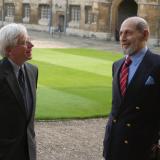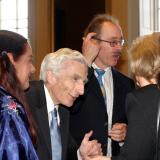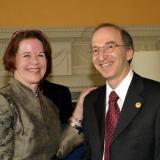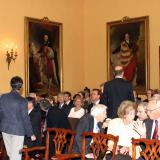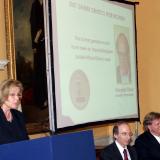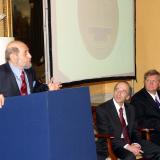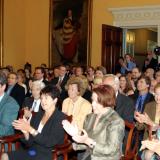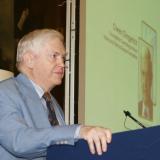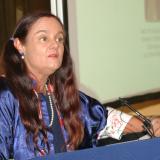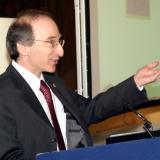2007 Gruber Cosmology Prize
Saul Perlmutter and Brian Schmidt and their teams: the Supernova Cosmology Project and the High-z Supernova Search Team, independently discovered that the expansion of the Universe is accelerating. Their discovery led to the idea of an expansion force, dubbed dark energy. And it suggested that the fate of the universe is to just keep expanding, faster and faster.
2007 Cosmology Prize Recipients
Laureate Profile
Saul Perlmutter and Brian Schmidt and their teams: the Supernova Cosmology Project and the High-z Supernova Search Team, discovered that the expansion of the Universe is accelerating.
An accelerating universe was a crazy result that was hard to accept. Yet, two teams, racing neck and neck, simultaneously came to the same conclusion. Their discovery led to the idea of an expansion force, dubbed dark energy. And it suggests that the fate of the universe is to just keep expanding, faster and faster.
The two teams expected to find that the universe would either expand then contract, or it would expand for ever but slowing over the millennia. But there were a growing number of hints that all was not right with the theories of the time.
To find out, they not only needed to be able to measure the speed with which distant objects are traveling away from us, but also how far away they are. And to do this they needed standardized light sources — very bright ones that would be visible to Earth-based telescopes despite being billions of light years away and billions of years old.
The standard light sources they used were exploding stars — in particular Type Ia supernovae. But finding them wasn’t easy. Then the analyses over the results turned up very surprising results. “The data wasn’t behaving as we thought it would,” says Schmidt. “There was a lot of nervous laughter,” says Perlmutter. For both teams it was not what they were expecting. For months they both tried to figure out where they had gone wrong, searching for any tiny source of error. But the data was right. The accepted model of the universe was wrong.
Today Perlmutter, Schmidt and their colleagues continue to explore the implications of their work. Schmidt is planning the SkyMapper project, a telescope to map the southern sky. Perlmutter is working on a satellite mission that would study supernovae and the nature of dark energy.
The $US500,000 prize will be shared in four parts: by Schmidt — at the Australian National University; Saul Perlmutter — at the University of California, Berkeley; and the fifty-one co-authors of the key papers.
Saul Perlmutter and the Supernova Cosmology Project Team from Australia, Chile, France, Spain, Sweden, UK and USA.
- Gregory Aldering, Lawrence Berkeley National Laboratory
- Brian J. Boyle, Australia Telescope National Facility
- Patricia G. Castro, Instituto Superior Técnico, Lisbon
- Warrick Couch, Swinburne University of Technology
- Susana Deustua, American Astronomical Society
- Richard Ellis, California Institute of Technology
- Sebastien Fabbro, Instituto Superior Técnico, Lisbon
- Alexei Filippenko, University of California, Berkeley (also a member of the High-z team)
- Andrew Fruchter, Space Telescope Science Institute
- Gerson Goldhaber, Lawrence Berkeley National Laboratory
- Ariel Goobar, University of Stockholm
- Donald Groom, Lawrence Berkeley National Laboratory
- Isobel Hook, University of Oxford
- Mike Irwin, University of Cambridge
- Alex Kim, Lawrence Berkeley National Laboratory
- Matthew Kim
- Robert Knop, Vanderbilt University
- Julia C. Lee, Harvard University
- Chris Lidman, European Southern Observatory
- Richard McMahon, University of Cambridge
- Thomas Matheson, NOAO Gemini Science Center
- Heidi Newberg, Rensselaer Polytechnic Institute
- Peter Nugent, Lawrence Berkeley National Laboratory
- Nelson Nunes, University of Cambridge
- Reynald Pain, CNRS-IN2P3, Paris
- Nino Panagia, Space Telescope Science Institute
- Carl Pennypacker, University of California, Berkeley
- Robert Quimby, The University of Texas
- Pilar Ruiz-Lapuente, University of Barcelona
- Brad Schaefer, Louisiana State University
- Nicholas Walton, University of Cambridge
And for the High-z Supernova Search Team: Brian Schmidt and his team from the USA, UK, Germany, Chile and Australia,
- Peter Challis, Harvard University
- Alejandro Clocchiatti, Pontificia Universidad Católica de Chile
- Alan Diercks, Institute for Systems Biology, Seattle
- Alexei V. Filippenko, University of California, Berkeley
- Peter M. Garnavich, University of Notre Dame
- Ronald L. Gilliland, Space Telescope Science Institute
- Craig J. Hogan, University of Washington
- Saurabh Jha, Stanford Linear Accelerator Center
- Robert P. Kirshner, Harvard University
- Bruno Leibundgut, European Southern Observatory
- Mark M. Phillips, Carnegie Observatories
- David Reiss, Institute for Systems Biology. Seattle
- Adam G. Riess, the Johns Hopkins University
- Robert A. Schommer (Deceased)
- R. Chris Smith, Cerro Tololo Inter-American Observatory, Chile
- Jason Spyromilio, European Southern Observatory
- Christopher Stubbs, Harvard University
- Nicholas B. Suntzeff, Texas A&M University
John L. Tonry, Institute for Astronomy, Honolulu
The key papers reporting their discoveries were: Riess et al., 1998, AJ, 116, 1009, "Observational Evidence from Supernovae for an Accelerating Universe and a Cosmological Constant"
Watch Video
Citation
The Peter and Patricia Gruber Foundation proudly presents the 2007 Cosmology Prize to Saul Perlmutter and Brian Schmidt, and to the Supernova Cosmology Project and the High-z Supernova Search teams, for their discovery that the expansion of the Universe is currently accelerating.
These observations required the development of new techniques that use supernovae exploding within distant galaxies to measure precise distances across a large fraction of the observable Universe.
The discovery of the accelerated expansion has radically changed our perception of cosmic evolution.




